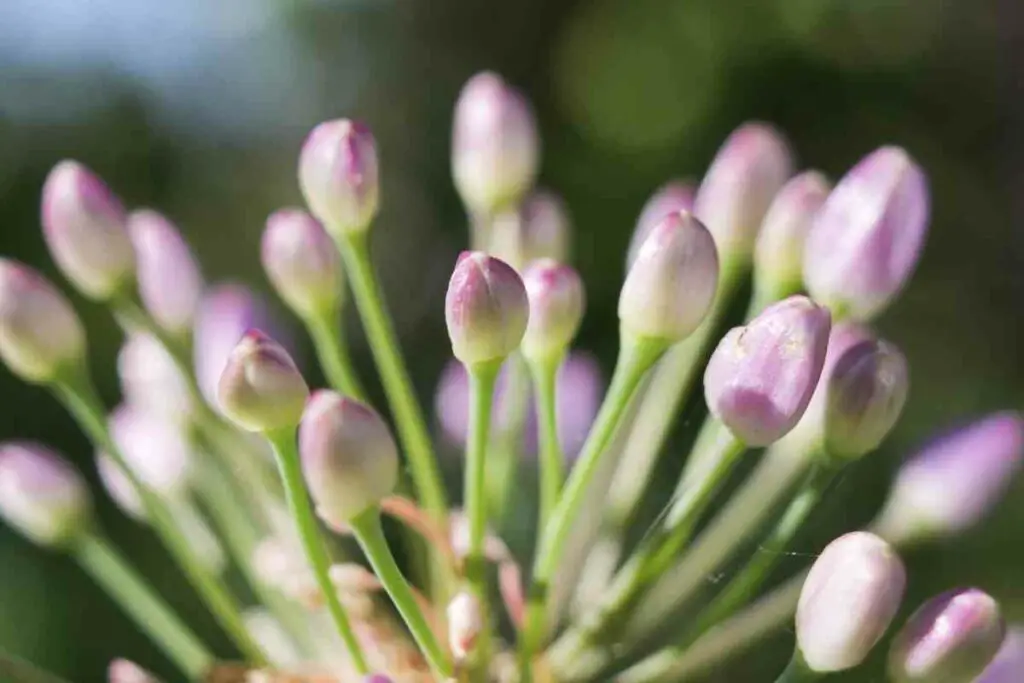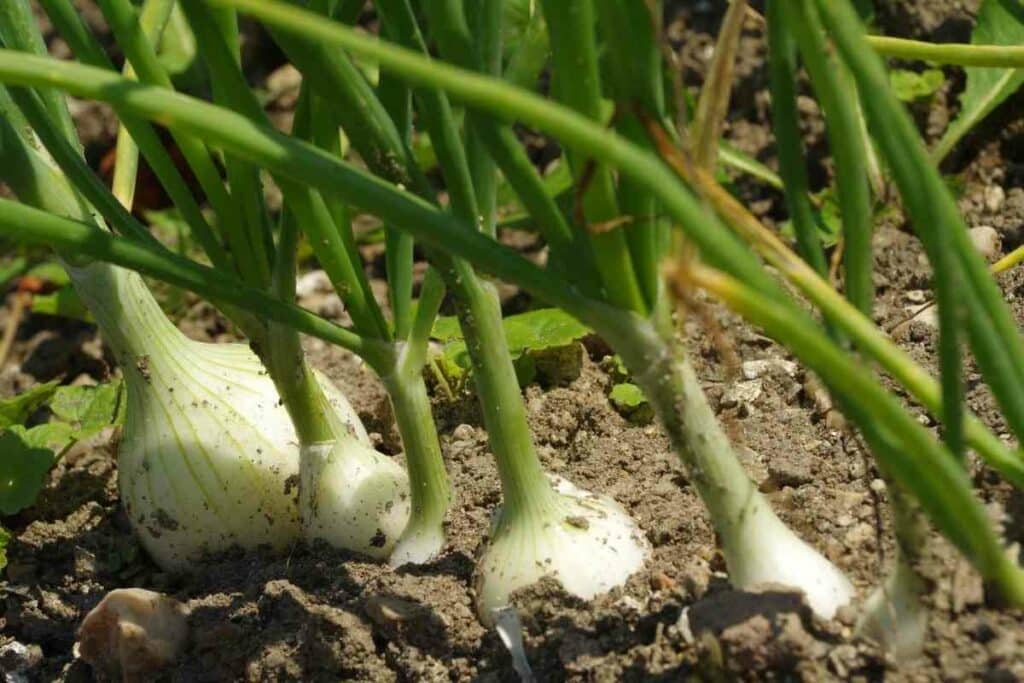Seeing onions with flowers is not uncommon. You can grow onions from seeds, young transplants, onion bulbils, or sets.
Flowering in onions is expected in the ones that grow from sets. Transplants and onions that grow from seeds are unlikely to flower if grown under ideal climate conditions.

Onion sets are miniature onion bulbs that were grown from seeds in the previous planting season. Farmers harvest the small bulbs and store them throughout the cold season.
Plant stores and gardens then sell them to other onion farmers in spring for replanting.
The ideal diameter size of the onion bulbs in sets is smaller than a nickel. However, the probability of producing flowers is higher in larger sets.
Unfortunately, onions that flower form small bulbs and are perfect for green onions.
What is bolting in onions?
Onions that flower prematurely or those not grown from sets are said to be bolting. Once onions sprout the flowering stalk, the bulbs stop growing.

Instead, the flowering stem and seeds use all the nutrients to develop the bulb.
Stress is the main factor behind bolting onions. If the onion plant receives a trigger, suddenly, it responds by undergoing premature reproduction.
This stimuli negatively affects the plant, stopping the development of bulbs.
The lifecycle of onions
Onions are biennial plants.
Biennial means they grow over the first year and flower in the second year. The term bolting refers to onions that flower within the first year of growth.
In the first year of growth, onions require nutrients and sunlight to develop and grow the underground bulbs.

At the beginning of winter, the onion leaves die, and the bulbs go into an inactive phase.
At the end of the first year, as the leaves wither, onion bulb harvesting is ready. However, onion farmers can choose to leave the bulbs as they are.
They will rest during winter and regrow to form flowering stalks at the start of the second year.
Since the onion plant has completed a lifecycle, it starts to flower in its second year. If you harvest the onions after the first season, the new crop will not bloom.
However, climate changes can trigger the onion plant to flower or seed prematurely. It sometimes happens during the first development season.
Causes of early flowering in onions
Onions with flowers are either in their second season of growth or prematurely flowering.
There are various causes of early or premature flowering in onions.
They include the following.
Sudden temperature drop
Onions start maturing during the warm season after initial planting.
The bulbs grow steadily in preparation for slow growth during winter.
However, the onion will stop growing if there is an unexpected temperature change.
The sudden cold temperature triggers the onion plant to think it has reached maturity prematurely. It gets into dormancy while the bulbs are still young.

Warm weather just before winter
Since onions begin slowing growth at the beginning of winter, if the temperatures suddenly become warm, it confuses them.
The plants will think it is the second season and start producing flowers and seeds.
Ways to prevent onions from flowering
The best way to limit onions with flowers in your garden is to correctly time planting time.
If you plant your onions early enough, they will be the right size at the start of winter.
They will mature sufficiently and remain dormant till the following season. In the following year, such onions will grow without producing flowers.
However, if you plant your onions late, they will not grow sufficiently by winter. Seedlings below 5 inches are still young to withstand the temperature changes.

They will go into dormancy prematurely and grow stalks that flower in the new second season.
Onion planting seasons differ depending on locations all over the US. Ensure you check the zone you are in before starting your onion garden.
The zonal markings will also determine if you plant onions from seeds, transplants, or sets.
The downside of not following your climate conditions is early flowering before the first season ends.
Keep in Mind – Late planting, on the other hand, causes your onions to produce small bulbs. Alternatively, the young seedlings fail to withstand the harsh climate during winter.
Consider covering your onions with a plastic tarp or growing them in a greenhouse to prevent sudden temperature changes.
Proper watering of onions during warm months will maintain the underground soil temperature. It will ensure the bulbs keep growing until they are ready for winter.
Ensure the soil around your onion plants is compact. Loose soils disturb the development of the roots.
If the roots do not get proper nutrition, the young plants will stop growing, further stressing them.
Lastly, fertilizer use has a direct impact on your onion plants. The extra nutrients can overgrow the bulbs during the warm months.
The large bulbs mature too early and trigger the growth of the flowering stalk. Use fertilizers in moderation, if necessary, and only after the bulbs have grown.
Can you still harvest onions with flowers?
Yes. You can still salvage your onions even after they produce flowers.
Underground bulbs stop growing once onions bolt. If you harvest them at this point, their shelf life reduces significantly.
Since the onions are susceptible to rot, harvest them and remove the leaves and flower stalk.

Cure them by spreading them out to dry in a warm, airy, and dry place. Once cured, ensure they are ready to eat in the shortest time possible.
One can replant the seeds that onion flowers produce to create new crops. The new seeds will save you money as you will not purchase new plants, an unexpected advantage of bolting.
Onion flowers are also an exciting ingredient in infused oil and vinegar. Their pretty color adds a statement to a meal.
The green flower stalks in bolting onions can replace leeks or green onions.
Chop off a few to add to salads or stir fry meals. You can add them to noodle soup and fried eggs for a great onion flavor.
Conclusion
Although onions flower, it does not mean you have lost your entire crop. Harvest the flowering crops and consume them immediately to prevent rotting.
Cutting off the flowering stalk will not save your onion plant. The stem grows through the underground bulb, so harvesting is the best remedy.
In the future, remember to choose the suitable varieties of onions for the climate conditions in your zone.
In the southern areas of the US, the onion variety, short-day, which requires about 12 hours of daylight, is ideal. Examples of short-day onions are Red Burgundy and Gabriella varieties.
North parts of the US grow the long-day onion variety. These require about 15 hours of daylight for proper bulb development. Examples of long-day onions are Walla Walla and Dakota Tear’s varieties.
Lastly, central parts of the US grow the day-neutral onion variety. Their bulbs will develop under any daylight condition.
Common day-neutral or intermediate onion varieties are Carbanet Red and Gladstone White onions.
Since onions grown from sets are most likely to flower, plant the large sets only. Their bulbs develop faster, allowing you to harvest the bulbs before they start to bolt.


